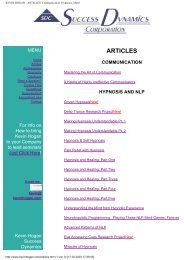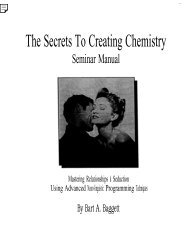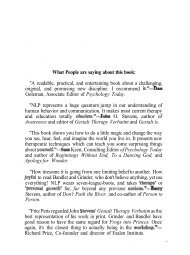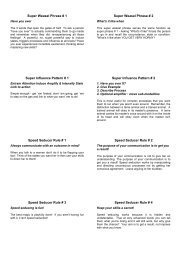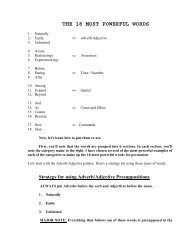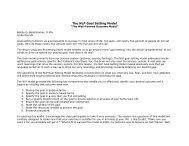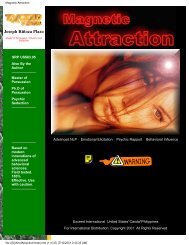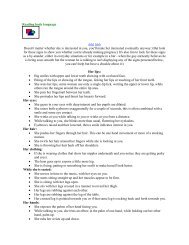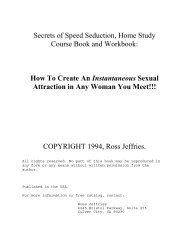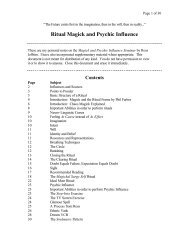A Pragmatic Guide To Communication & Change.pdf - NLP Info Centre
A Pragmatic Guide To Communication & Change.pdf - NLP Info Centre
A Pragmatic Guide To Communication & Change.pdf - NLP Info Centre
- No tags were found...
You also want an ePaper? Increase the reach of your titles
YUMPU automatically turns print PDFs into web optimized ePapers that Google loves.
the linguistic level (see Chapter III), we are operating on a person's 4-tuple at the level<br />
of social constraints. At the level of individual constraints, we assist people in<br />
understanding how their models of the world are dysfunctional, how they are causing<br />
unnecessary pain and hardship in their lives, or how they block the awareness of<br />
alternative thoughts, feelings or actions.<br />
Ultimately, any learning or therapeutic experience that is successful becomes a part of<br />
a person's personal history. Filed into his Memory Box, the new model will begin to<br />
shape thinking and perception in new, positive, and healthy ways.<br />
It is important to point out, as did Bundler and Grinder,''' that this discussion of<br />
constraints on the model building processes is not meant to be a comprehensive<br />
presentation, nor is it meant to imply that there are distinct divisions between the three<br />
constraints. They actually overlap. The purpose of this book is to present the reader with<br />
models for perceiving, predicting, and influencing behavior. They are useful for these<br />
purposes even though they are inaccurate: A model merely represents what it is<br />
modeling.<br />
Complex Equivalents<br />
One example of overlapping constraints concerns lan. guage. One to the influence of<br />
neurological and individual constraints, internal representations of language (social<br />
constraints) are different for everybody. For every word learned, everyone has a<br />
somewhat different internal experience. These specific experiences associated with words<br />
are called complex equiualents.'" Usually the subtleties between people's understanding<br />
of words are irrelevant. However, there are words that sometimes lead to misunderstanding<br />
between people. Words like loue, relationship, partnership, fear, power, trust,<br />
respect, and any expressions linked with a person's perception of himself and the<br />
environment are critical to the process of communication, as the example below<br />
demonstrates.<br />
24<br />
interpretation of personality based on a knowledge of that individual's personal history.<br />
Individual constraints, the third in the series discussed here, are the direct result of<br />
personal experiences. Taken as a whole, they are what form a person's historical<br />
background.<br />
Individual constraints are based on both neurological and social constraints, the two<br />
underlying filters of experience. As a person continues tloe process of construction and<br />
modification of his model of the world, it is individual constraints that form the fabric of<br />
his belief and value systems. They play an important part in what makes up the "rose" in a<br />
person's "rose-colored glasses." It is personal history in part that explains why a ghetto<br />
youth is less likely to score as high on the Stanford-Binet intelligence test as a youngster<br />
from an "upper class" family. These constraints also account for part of the diversity of<br />
scores on tests like the Minnesota Multiphasic Personality Inventory.<br />
Important to our understanding of individual models of the world is the concept of<br />
internally generated stimuli. As previously mentioned, for every moment in time, we<br />
create a 4-tupte of experience. This includes the parameters of visual experience (V);<br />
feelings, which include tactile, proprioceptive, and somatic experiences (K); the<br />
experience of sound (A); and smell and taste, also known as olfactory and gustatory<br />
experience (OG). We also have an immense collection of stored experiences, called<br />
memories. These memories can be manipulated, shuffled, and reorganized in very



